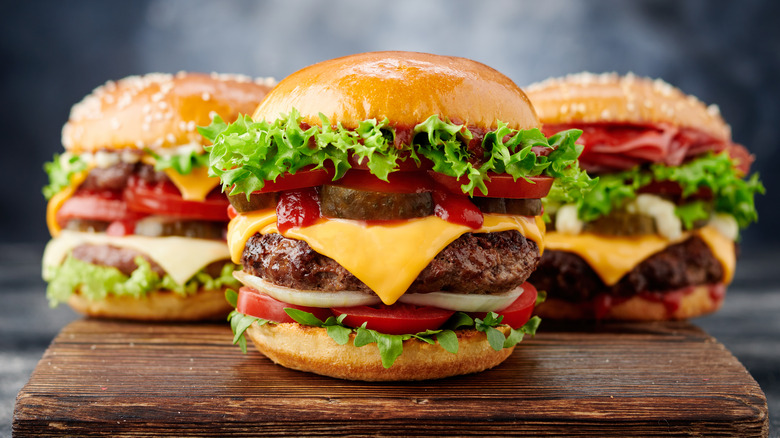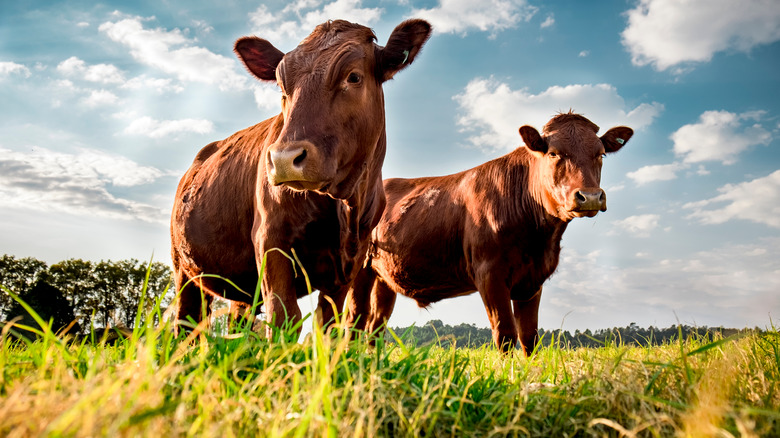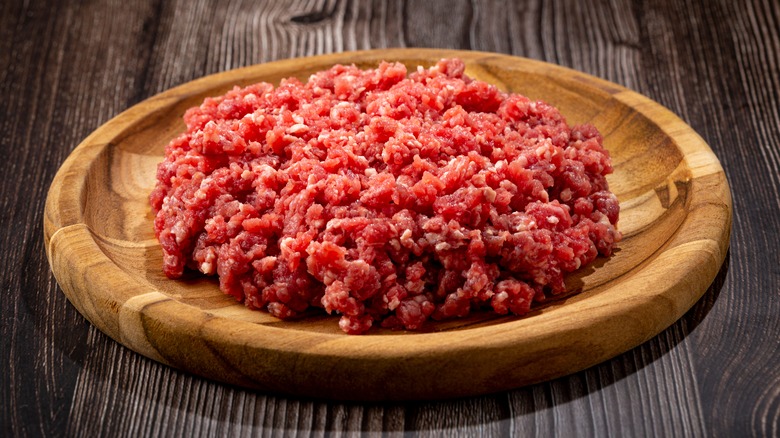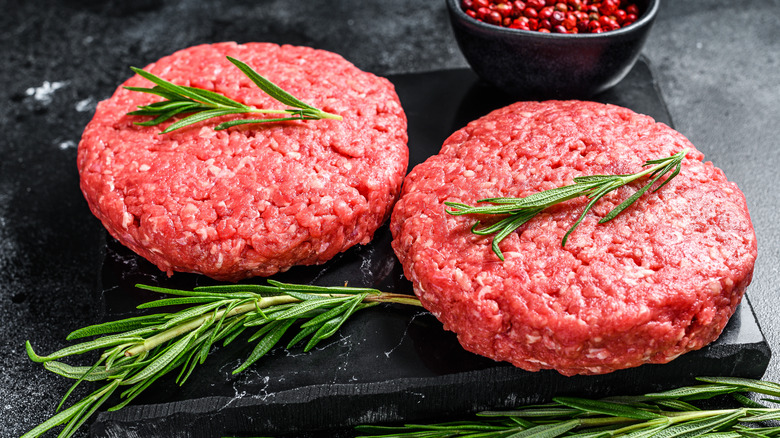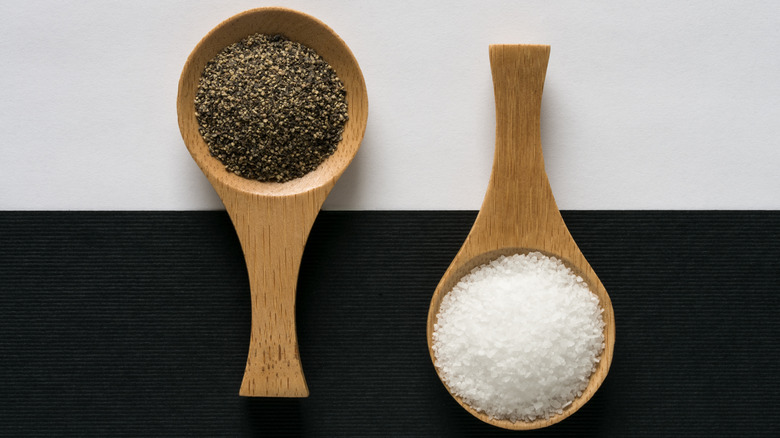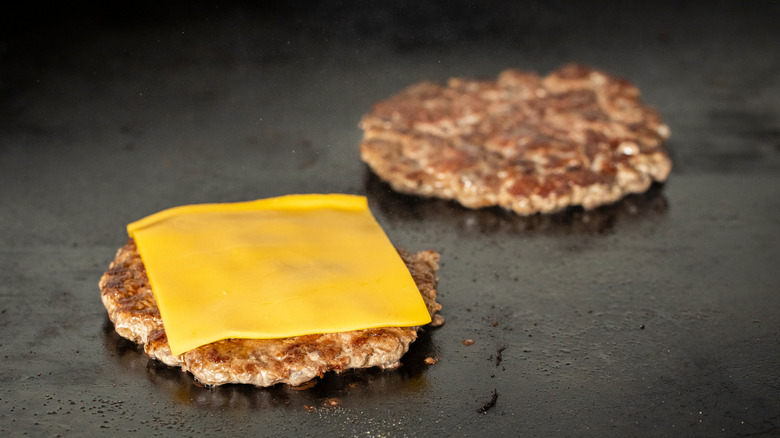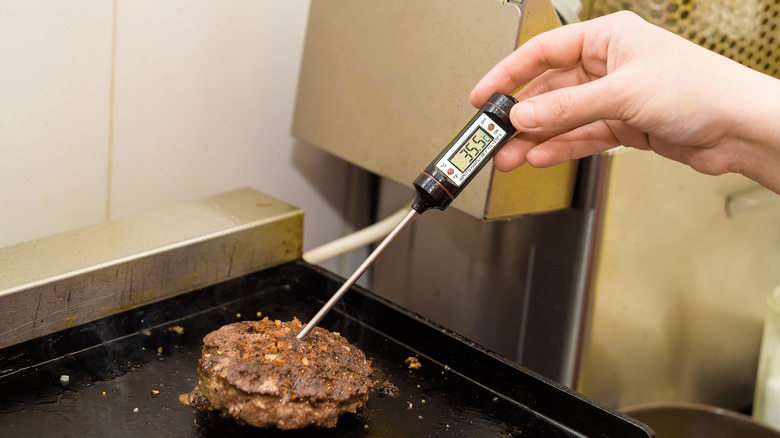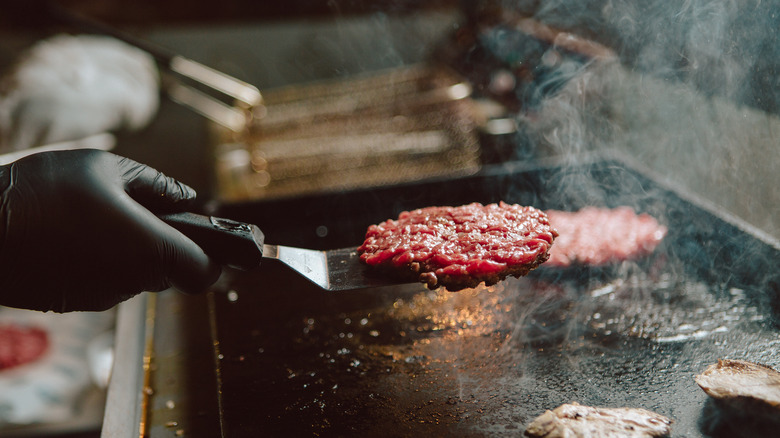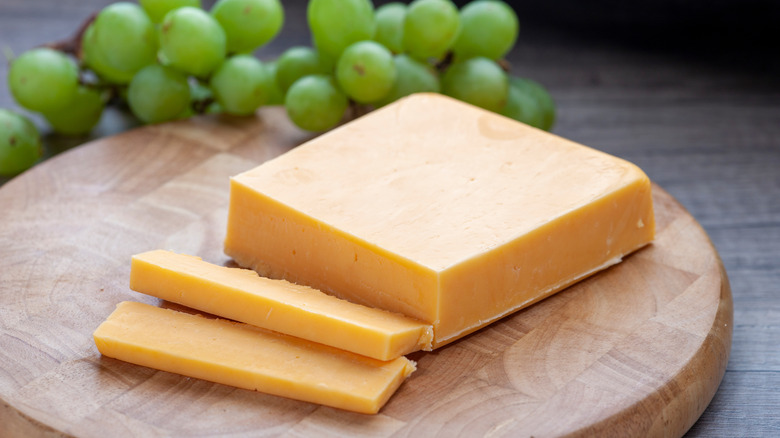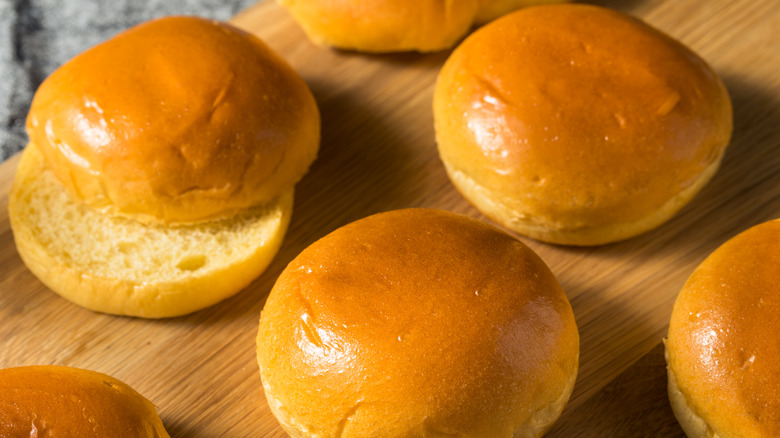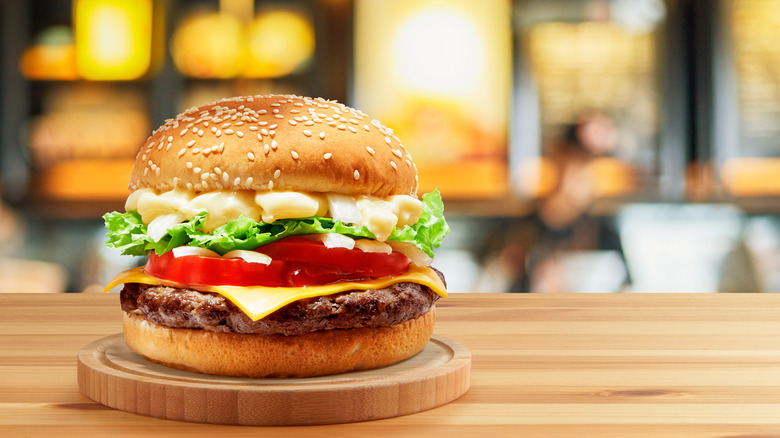What Makes Restaurant Burgers Taste Different From Homemade Burgers?
Statistically, there's something special about hamburgers. As The Washington Post points out, while people in the United States have steadily consumed less and less beef between the mid-1970s and today, hamburgers have bucked that trend and only increased in popularity.
In fact, NPD's receipt harvesting service, Checkout, found that over a 12-month period spanning 2018 and 2019, restaurant customers were almost twice as likely to order a burger than a chicken sandwich. So, it's not surprising that many at-home cooks would try their hand at creating a mouthwatering, restaurant-worthy burger from the comfort of their own kitchen. And, theoretically, this seems like a simple three-step process: grind the meat, shape the patties, and cook the patties. And yet, more often than not those home burgers never seem to achieve that savory dish found in many restaurants.
The truth is, like so many foods, there's an alright way and a professional Iron Chef way to prepare a hamburger. Does that mean every restaurant makes hamburgers the exact same way? Of course not. But if you truly love a particular restaurant's burger, there's an excellent chance that the chefs there are using at least some of the tricks below to craft an especially delicious dish.
Restaurant-quality burgers start with the right beef
One of the reasons why it's so easy to cook hamburgers at home is because it's simple to find pre-shaped, ready-to-cook hamburger patties at the supermarket. But even though they're convenient, they might not yield restaurant-level burgers.
As Ben Turley, the co-owner of The Meat Hook butcher shop, told GQ what you feed cattle makes a difference when it comes to your hamburger's flavor. Commodity beef comes from cattle that ate things like soy, sugars, and corn. Because of this, the meat has a sweeter flavor than cattle that ate grass. But even then there's something else a hamburger chef must keep in mind: Did the cattle eat grass all of its life? According to Verde Farms, grass-fed beef is from cattle that ate grass in the beginning but were then fed either supplemental grain feed or were given only grain. Grass-finished beef is from cattle that only ate grass.
While opting for grass-fed or grass-finished beef can make all the difference in crafting a truly savory hamburger, Turley told GQ that even professional chefs might be getting commodity beef since it's the majority of meat on the market. With that said, working with professionals like farmers and butchers can ensure that a chef gets the most ideal beef for their hamburgers.
Flavorful restaurant-worthy burgers need some fat
Some people are conscientious of their fat consumption, and, for others, it's not a big part of their thought process when choosing what to eat. With that said, if you love the flavor of a particular restaurant's hamburger, it's almost certain that they used a certain amount of fat in their burger's patty.
Hamburger authority George Motz is a documentary filmmaker who directed "Hamburger America" (via New York Times). He explained to the Times that the ideal amount of fat for a patty should be 20%, or you might wind up with a less juicy, drier burger. However, as Michael Symon, who in addition to hosting ABC's "The Chew" is also a proprietor of a small chain of hamburger restaurants, told the Times that around 30% fat can lead to issues like "shrinkage." He did say, however, that a patty can be 25% fat.
Besides the fat, what cut of beef goes into a hamburger can vary from restaurant to restaurant. For example, some establishments use meat blends that can include short rib, strip steak, brisket, clod, and hanger, per New York Times. The Minetta Tavern in Manhattan has a Black Label blend that is in part made from dry-aged New York strip steak. However, Motz recommends using ground chuck steak for the ideal hamburger patty.
Patty size is crucial for restaurant burgers
Imagine this: Two friends love hamburgers. These meaty sandwiches are their go-to item when eating out. However, when each of them tries to describe their ideal hamburger, they describe two different sounding dishes.
Now, let's set aside that everyone has different tastes regarding toppings and condiments. Just the burger itself can be vastly different, depending on the restaurant. As The New York Times reports, hamburgers from restaurants tend to be either smashed thin with crispy edges or plump, tender, and charred. So, depending on which version a restaurant wants to feature on its menu, the chef must carefully measure out the patty. For instance, the thinner burger like the kind found in diners usually comes from a patty that's weight is only 3-to-4 ounces while it's still raw. The thicker burger, which is often seen in pubs, is usually 7-to-8 ounces precooked.
But wait, aren't there "monster-size" burgers at some restaurants? Yes, but as Geoffrey Zakarian, the chef and owner of the National Bar and Dining Rooms in Manhattan, told The New York Times, "You want to get some heat to the inside of the burger. You don't want some giant, underdone meatloaf." For that reason, he warned that hamburgers weighing more than half a pound can be a bad idea.
Burger experts are particular about seasoning
Think about the last time that you ate something at a restaurant that had too much seasoning. Even if the results weren't spicy, you still probably experienced a combination of flavors that overwhelmed each other and the dish. However, when it comes to a hamburger, chefs understand that it's not only a question how what you season it with, but when during the patty-making process you add the seasoning.
As culinary scientist Jessica Galvin explains on her website, kosher salt and freshly ground black pepper can be an ideal seasoning pair for hamburgers. With that said, it's crucial to first form the patty and then add the seasoning to the outside of it rather than mixing the salt and pepper into the patty's meat, via Reader's Digest. Otherwise, the texture of the hamburger could be affected. "What you end up with is a very tightly compacted patty whose texture is similar to sausage," Test Kitchen expert James Schend told Reader's Digest.
In addition, Galvin cautions on her website that adding the seasoning too soon to the outside of the patty could also make it more like a sausage texture-wise. She advises waiting until just before grilling to sprinkle the salt and pepper over both sides of the patty for the best results.
Restaurants tend to use flat top grills or griddles
Many people associate cooking hamburgers with a barbecue grill. However, chances are if you love how a particular restaurant prepares their burgers, they're probably using a griddle or a flat-top grill. But that's not the only possible cooking tool that might be in a professional kitchen's burger-making tool kit.
The surface of a griddle can help give a restaurant's burger that mouthwatering charring. But, just as important, the griddle also allows the professional burger chef to prepare other elements of their burger masterpiece like sautéed onions and a nicely toasted burger bun. Of course, these are prepared on different areas of the griddle than the burger patty itself, but that's another big advantage — griddles can be utilized as a multi-cooking surface. And if you're a cheeseburger fan, the professional burger chef adds the cheese while it's still on the griddle. The trick is to put a little water on the griddle itself and then immediately cover the patty and cheese with a lid. This way the steam from the water perfectly melts the cheese over the patty.
While flat top grills and griddles are the choices of many restaurants, a cast iron pan is an invaluable burger-cooking kitchen tool used by culinary professionals. Bobby Flay said on The Today Show, "Cast iron has excellent heat diffusion and retention and produces evenly cooked burgers with a really great crust."
Burger chefs don't guess about temperature
You've probably met someone who claims that they can tell when a burger is done cooking by its appearance or its feel when they poke it. Now, there's no doubt that seasoned professionals develop a certain instinct for the foods they make, but if your favorite restaurant always cooks your burger to perfection, there's an excellent chance the chef is using a special thermometer.
Meat thermometers can be valuable tools for cooking burgers. After all, the last thing anyone wants to do is serve undercooked meat, which, as the U.S. Department of Agriculture (USDA) points out, can be dangerous. But after going through so much work crafting the perfect burger patty, a professional doesn't want to overcook it either. And, remember, there are several ways to prepare burgers, ranging from rare to well done. But by using a reliable meat thermometer, a chef can know for a fact what temperature their patty is and whether or not they need to cook it longer.
One final caution about temperature: The USDA warns that a hamburger should have a minimum internal temperature of 160 degrees F to get rid of unsafe bacteria. However, only hamburgers that are well done fit this criterion. So, when you order hamburgers at a restaurant, you might want to keep this in mind.
Chefs don't repeatedly press burgers
If you guessed that there's a method for achieving that perfectly flat, juicy, burger that's popular in many restaurants, you'd be correct. Mark Rosati, the culinary director of Shake Shack, explained that the trick is to use two spatulas to smash the burger patty. The first one should be a sturdy metal one that's pressed directly against each burger while the second one presses on top of the first one.
While that initial pressing is important, a chef doesn't repeatedly press down on a burger. In fact, that initial smash should happen within the first 30 seconds of cooking the burger patty. Why? Well, think for a moment about the last time you were at a barbecue where hamburgers were being served. Did you often hear sizzling sounds beyond just the normal noises foods make while they're being cooked? If you answered "yes," there's a good chance the person doing the cooking was pressing over and over again on the hamburgers, and in the process, pressing out their juices. This can lead to a less flavorful meal. But the single, immediate smash method can help lock in those juices.
Although burger chefs don't repeatedly press hamburgers, they do flip them — but again, timing is everything. As Bobby Flay told The Today Show, "Do not even start flipping the burger until a crust has formed or the meat will fall apart, and you will lose that perfect round shape."
Restaurants pair burgers with certain cheeses
Undoubtedly, you've been to a restaurant where you had a cheeseburger topped with classic American cheese. And there's nothing wrong with that. In fact, it's an incredibly common ingredient for the at-home burger cook. But just because it's practically the go-to for cheeseburgers doesn't mean all hamburger chefs rely solely on this type of cheese.
According to The Wisconsin Cheeseman, multiple kinds of cheese pair well with hamburger meat. For instance, both white and yellow cheddar cheese can give a tangy flavor note to a cheeseburger. And while the burger chef can opt for a sharper cheddar, the mild varieties tend to melt better, which can enhance a cheeseburger dining experience. Another item you've probably encountered at a restaurant is a mushroom Swiss burger. But, remember, there is more than one type of Swiss cheese, and it's very likely a restaurant chef will choose the milder baby Swiss for their cheeseburger creations. Additionally, The Wisconsin Cheeseman points out, "Many upscale steak restaurants often feature blue cheese on their burgers along with high-end bacon (such as Nueske's from Wisconsin) because the combined effect of both creates one of the richest hamburger tastes around."
Of course, these are just a few of the cheeses a hamburger chef might use. As The Wisconsin Cheeseman explains, brie, gouda, Monterey Jack, and goat cheese are all good choices for cheeseburgers. The bottom line is a chef must consider many factors when selecting the perfect cheese for their cheeseburger creation.
Restaurants use more than one type of bun
Once a burger patty is done cooking, it's time to put it on the bun, correct? Actually, not quite since burger chefs usually set a burger aside for a few minutes before putting it on their bun of choice.
Now, for many people, a sesame seed bun seems like the first and last choice for a burger. And it's a safe bet that you've seen this bun in many restaurants that feature hamburgers. But it's most definitely not the only option. Take The Capital Grille restaurant chain, for example. Its 8-oz burgers are served with brioche rolls. And make no mistake, this one change does create a different dining experience. Remember, brioche has a sweetness not present in some other kinds of bread, per Britannica. In fact, brioche is often put into the category of a breakfast pastry and is similar to baked goods like Danishes, croissants, and beignets. So, when a chef chooses this type of bread for a burger, it adds a subtly sweet touch to an otherwise savory meal.
With all of that said, brioche is only one example of the type of bread a restaurant might use for their burgers. According to Mashed, potato buns are also a good option for burgers. And while restaurants might feature burgers on pretzel rolls, keep in mind that these rolls are not as soft as brioche and potato buns.
A made-to-order burger includes toppings
Arguably, no burger is complete with toppings. However, this last step in hamburger making is more involved than most people realize. Yes, two burgers can technically have the same topping ingredients, but what a restaurant does with those ingredients can make all the difference in the final product.
To fully appreciate this, let's look at three different restaurants that each feature a burger topped with onions. The Capital Grille restaurant chain has The Capital Grille Cheeseburger, which is served with grilled onions. However, Minetta Tavern in New York City puts cheddar and caramelized onions on its Minetta Burger. And yet another New York City restaurant, Butcher & Banker, describes its Butcher Burger as having "bacon, onion rings, & smoked cheddar." And, let's forget that there are many varieties of onions, each with its own unique flavors and properties. A chef needs to be aware of these details and how they can change and enhance their burger creations.
Even if onions aren't your favorite burger topping, this is just one example of how a restaurant burger can vary from a homemade one. After all, trying to replicate a restaurant's burger but not knowing all of the factors like what specific ingredients are being used and how exactly they were prepared can make a huge difference.
